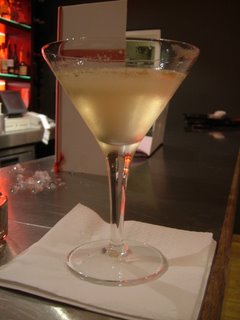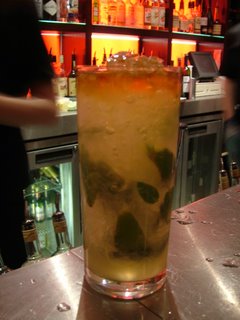I enjoyed finding out about Raymond Chandler’s gimlet so much that I wanted to learn more about authors and their drinks. So here’s the very thing: a guest post on ‘Literary Cocktails’ by Liz Upton from Gastronomy Domine. Everything you ever wanted to start to know about writers and their cocktails (and if it’s Wellington Beervana news you’re after then it’s Neil’s Malthouse blog you’ll be wanting, and the Twitter feed you’ll be needing ). Take it away Liz, direct from a night out at the River Bar in Cambridge, England . . .

The Kitchen part of the River Bar and Kitchen is not as glorious as the Bar part, so I'll gloss over it; I ate there with some friends a couple of weeks ago and was rather disappointed (dry meats, vinegary preparation, identikit saucing). The cocktails, though, are well worth a visit.
A few months ago, gurgling happily over a Manhattan (equal measures bourbon and vermouth, with a cherry and some orange zest and a dash of bitters), I was told by a friend with something pink and creamy on the end of her nose that I only like pretentious grown-up cocktails. I think this means that I prefer cocktails which aren't sugary and full of things squirted out of a cow, but I will admit to a certain mental frailty - I get a tiny kick (OK, a massive one) out of the Literary Cocktail. Knowing which brand of lime cordial you should use to make a Gimlet like the kind Philip Marlowe enjoyed, and being able to argue with the barman about it. That kind of thing.
The drink at the top of the page is a perfect example of pretension in cocktail form, and it's my very favourite cocktail, the alcoholic drink I would happily forgo all others for; a Vesper Martini. This is the original Martini James Bond creates in Casino Royale (1957, the first Bond book), named for Vesper Lynd, Bond girl and double agent. He instructs the barman:
'In a deep champagne goblet . . . Three measures of Gordon's, one of vodka, half a measure of Kina Lillet. Shake it very well until it's ice-cold, then add a large thin slice of lemon peel.'
Bond [or Fleming] knew what he was talking about; this is a beautiful cocktail.
Kina Lillet is a vermouth, and the guy at the River Bar uses only a tiny breath of vermouth; he says tastes have changed since the 50s. (They certainly have; Tom Lehrer sang about 'Hearts full of youth/Hearts full of truth/Six parts gin to one part vermouth' in Bright College Days, and this is a very vermouth-y Martini indeed to my youthful, truthful tongue.)  My next Martini was a Zubrowka (a vodka flavoured with fragrant bison grass, which is added during distillation) one. I have a great love for W Somerset Maugham. In The Razor's Edge, Isabella says:
My next Martini was a Zubrowka (a vodka flavoured with fragrant bison grass, which is added during distillation) one. I have a great love for W Somerset Maugham. In The Razor's Edge, Isabella says:
'It smells of freshly mown hay and spring flowers, of thyme and lavender, and it's soft on the palate and so comfortable, it's like listening to music by moonlight.'
Even though her ultimate aim in rhapsodising about the stuff is to drive another character to a sodden alcoholic grave, I can't help but feel Maugham himself must have been pretty keen on Zubrowka too. (Another Somerset Maugham favourite was avocado ice cream, which is, you may be surprised to learn, absolutely divine - watch this space.)
For some reason I can't fathom, some apple schnapps and other fruity stuff found its way into my Martini when I wasn't standing at the bar to keep a firm hand on the barman (there really shouldn't be anything other than gin or vodka and vermouth - find me the man who invented the chocolate martini and I will show you an man without tastebuds but with an uncanny understanding of what drunk women will pay for), but it was still pretty fabulous. Excuse the lipstick on the rim in the photograph. It is hard to remember to photograph your Martini before drinking it when you've already had a few.  My friends were now on the champagne cocktails. In the back here is a Carol Channing. Those who have seen Thoroughly Modern Millie, a glorious film with Julie Andrews, Mary Tyler Moore, James Fox and a biplane, will remember Carol Channing's dance with the xylophone and her habit of shouting 'Raspberries!' A Carol Channing is made with muddled raspberries, sugar syrup, Chambord and raspberry eau de vie, topped up with champagne.
My friends were now on the champagne cocktails. In the back here is a Carol Channing. Those who have seen Thoroughly Modern Millie, a glorious film with Julie Andrews, Mary Tyler Moore, James Fox and a biplane, will remember Carol Channing's dance with the xylophone and her habit of shouting 'Raspberries!' A Carol Channing is made with muddled raspberries, sugar syrup, Chambord and raspberry eau de vie, topped up with champagne.
In front is a proper champagne cocktail - that is to say bitters soaked into a brown sugar lump, with champagne poured on top. A lovely drink, and a very, very old fashioned cocktail; it first pops up in 1862 in Jerry Thomas's How to mix drinks. (Click the link for an online facsimile of the book.) There are only a very few true cocktails in the book (the other recipes are flips, juleps, punches and recipes for flavoured syrups and so forth), and the champagne cocktail is the only one you're likely to recognise in 2005.  Somebody (as the evening wore on I lost track of who was ordering what. Can't think why) ordered a Mojito (muddled mint and sugar, rum, lime and soda water). A Brazilian friend has special mint-muddling pots and sticks, like a conical mortar and pestle, for making these; she brings cachaça, a Brazilian rum, home to England when she visits her family, and uses it to makes the best Mohitos and Caipirinhas (lime, soda, cachaça and sugar) I've tasted.
Somebody (as the evening wore on I lost track of who was ordering what. Can't think why) ordered a Mojito (muddled mint and sugar, rum, lime and soda water). A Brazilian friend has special mint-muddling pots and sticks, like a conical mortar and pestle, for making these; she brings cachaça, a Brazilian rum, home to England when she visits her family, and uses it to makes the best Mohitos and Caipirinhas (lime, soda, cachaça and sugar) I've tasted.
I should wrap this post up. ‘Mr Weasel’ is on his way home from the supermarket; he has gone to fetch a bottle of Big Tom's tomato juice, which we will adulterate with some vodka I've been steeping chilis in for a few months. I love weekends. Those wondering about the Philip Marlowe Gimlets, by the way, should read The Long Goodbye, where Marlowe informs us that 'A real gimlet is half gin and half Rose’s Lime Juice, and nothing else. It beats martinis hollow.' He's right; Rose's is the only one made only with real, fresh limes. Try it some time - cut down on the Rose's if you find it too sweet. [And if you really want to know even more, then try A Gimlet for Mr Chandler.]
Cheers
Liz
5 comments:
Out of the book I am currently working on:
"...They adjourned to the kitchen where Sharon loaded up a large blender with ice, Navy Rum, Galliano, Southern Comfort, Coconut liqueur, Vodka, orange juice, pineapple juice, lime and coconut cream.
"Wayne taught me the recipe- ‘Privateer’s Gold’ he calls it. The damned stuff is lethal!”..."
Ahh. I've just discovered the Old Fashioned...see The Cocktail Renaissance...
http://www.weeklystandard.com/Content/Public/Articles/000/000/016/772lyldx.asp
...and just in case you can't be bothered looking it up...
"...like an Old-Fashioned or a Daiquiri. These are things anyone should be able to make and involve only the simplest of ingredients. An Old-Fashioned is a sugar cube wetted down with two to three large dashes of Angostura bitters and crushed until no trace of the crystals remains. Add some water--not much, the amount depends on the quality of your brown--two ounces of excellent rye whiskey (or bourbon, of course), and three cubes of ice. Stir and let it sit for a moment while you slice a nice stripe of lemon peel--all peel, none of the white pith--to squeeze over. (You'll see the slick of citrus oil as you raise the glass for your first sip.) It's perfection incarnate..."
Try this little essay.
http://www.rmastudies.org.nz/entertainments/55-entertainments/105-the-martini-gospel-according-to-mcshane
That's disgraceful Owen on at least three counts.
Your 'Martini Gospel According to McShane' only makes the barest of literary connections.
You recommend gin instead of vodka!
And worst of all, you didn't offer me one last time I was there.
Appalling all round. ;^)
Post a Comment